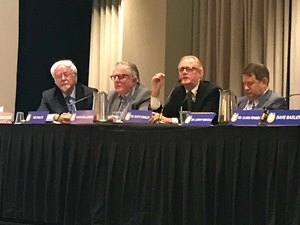Horsemen's Panel Addresses Concerns About Contamination


With the capabilities of drug-testing labs becoming ever more sensitive, a panel at the National Horsemen's Benevolent and Protective Association convention March 16 in New Orleans called for changes in rules, regulation, and backstretch behavior.
The panel of veterinarians and scientists called for:
- Rules to view low levels of some substances found in testing to be recognized as contamination;
- Increased screening of workers to discover anyone who potentially could cause contamination;
- More study of backstretch surroundings by using swipe tests on the test barn and in stalls;
- Tests of food and water;
- Independent laboratory accreditation.
The panel also noted there has to be awareness of the potential for contamination on the backstretch, noting some contamination cases have been linked to humans urinating in barns.
Dr. Tom Tobin of the Gluck Equine Research Center said contamination sources can include therapeutic medications used in horses, human prescription or over-the-counter drugs, or human drugs of abuse. Tobin cited a 2016 study at Hollywood Casino at Charles Town Races where swabs of stall walls found a number of substances.
Tobin said the takeaway from the Charles Town study is a high likelihood of contamination in those conditions. He added it would be good to follow with a study that would place horses in similarly contaminated stalls to study any transfer that occurs.
Dr. Levent Dirikolu presented on the potential for cocaine positives caused by contamination. He noted labs that only detect the cocaine metabolite benzoylecgonine should not call a positive. He said if a horse had, in fact, been administered cocaine, the lab should see other metabolites.
Ted Shults, a forensic toxicology and law expert, said that in human drug testing, more safeguards—low levels are viewed as contamination as opposed to a positive—are in place that recognize the potential for contamination. He said similar safeguards are needed in equine testing.
The panel noted some progress is being made in recognizing the potential for contamination. Veterinarian Clara Fenger said Kentucky cited new research in overturning a dextromethorphan positive from 2015. Dextromethorphan is used to treat cold and flu symptoms in over-the-counter human medicines like NyQuil.
Tobin noted that in 2015 the British Horseracing Authority ruled that trace levels of tramadol, the active ingredient in the human-prescribed arthritis medication Zydol, found in a horse were caused by his trainer urinating in straw in the horse's stable.
New York safety steward Hugh Gallagher, who provided some regulatory perspective, noted that the current model rule also holds protections for horsemen. He said the rule notes that if the preponderance of evidence in a positive was caused by human contamination, it can be a mitigating factor.
Gallagher said it's critical humans don't "use horse stalls as a bathroom," and that no coffee, tea, energy drinks, or chocolate is ever allowed in the area. He said regulators need to work to keep collection areas hygienic and regularly sanitize sample stalls.
"That's critical that it take place," Gallagher said of sanitizing the stalls. "That's a minimal obligation."
